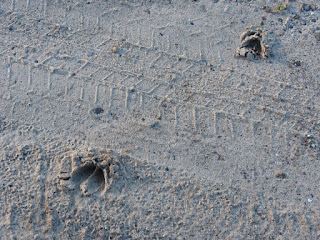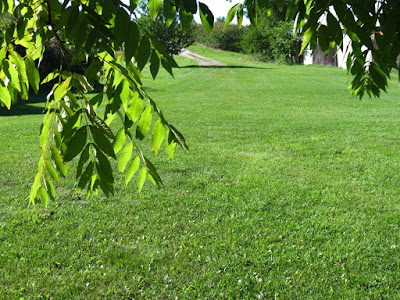Scheduling
outdoor events in Michigan always means hoping the odds will be in your favor,
so everyone in Northport was thrilled with the weather on Saturday, September
26, for the third annual Leelanau UnCaged street fair. My only photographs are
from the morning setup. Official fair hours were from noon to 10 p.m., but I
managed to snag a breakfast pretzel earlier than that from a vendor over on
Nagonaba Street before opening my bookshop to put in a 12-hour day.
One
of our friends commented afterward that the event was like a reunion – “For
everyone!” he added enthusiastically. It’s true that we saw many friends we
don’t see all year long and some we hadn’t seen for many years. We enjoyed our
day and arrived home exhausted, agreeing that (1) Sarah could not be a better
dog and (2) the three of us have a very good life.
We
slept late on Sunday and went out to breakfast, then came home to rest a little
more. When I got a burst of energy, I went outdoors to lop away at the
re-emergent popples for a couple of sweaty hours.
 A
friend had invited us for Sunday evening dinner. He said not to bring any food
or wine, as he was trying to clear out his pantry for the season, but to be sure to bring Sarah so she and his dog could enjoy the evening together, and we were
to wear warm clothes because dinner was to be served on the deck overlooking
Lake Michigan. I didn’t take my camera (you'll have to imagine Sarah and Charlotte, so excited to see each other again, running around and around the house and yard) but did take a few photographs
of the bouquet I picked to take our host.
A
friend had invited us for Sunday evening dinner. He said not to bring any food
or wine, as he was trying to clear out his pantry for the season, but to be sure to bring Sarah so she and his dog could enjoy the evening together, and we were
to wear warm clothes because dinner was to be served on the deck overlooking
Lake Michigan. I didn’t take my camera (you'll have to imagine Sarah and Charlotte, so excited to see each other again, running around and around the house and yard) but did take a few photographs
of the bouquet I picked to take our host.
Here’s
what’s funny: For years I wanted asters, and every fall when I saw wild asters
blooming along the roadside I’d try to make a mental note (it never stuck) to
go back and gather seeds. When we had a new septic system put in for our old
farmhouse, I sowed a large area with native grass and mixed wildflower seeds.
The asters didn’t bloom the first year, maybe not even the second. I don’t
remember. But then one year, there they were, right in my own backyard.
Somewhere once I read that happiness does not consist of getting what you want but in wanting what you have. With my asters, it works both ways.
Monday
was another day we spent largely and luxuriously at home. (I say “luxuriously”
because I love being home, and it’s a luxury for us working people.) My outdoor
project on Monday was mowing grass. It’s been a long grass-mowing season this
year. After dinner we went for a long, slow, meandering county cruise.
One
of our stops that evening was our friend George Powell’s boat shop. Below is George at work on a boat that is older than I am (“but not older than I
am,” David put in), using a Japanese longshoreman’s tool he also used up in Grand Marais when he worked on restoring the historic pickle barrel.
Boats
are beautiful, but an old tractor in the weeds is certain to distract me from
maritime vessels....
And
now it’s Tuesday, the sky is cloudy, a front has moved in and the temperature
has dropped. We closed the windows at home. David put it in a single word:
“Fall!”
The next book I write about here will be one I'll be re-reading. Bonnie Jo Campbell's new collection of short stories, Mothers, Tell Your Daughters, has an official release date of October 5, and Campbell will be at Dog Ears Books on Wednesday, October 14 -- at noon sharp! I've read the ARC and want to read it again and have the stories fresh in mind before sharing my thoughts but will urge you now to mark your calendar and do not forget the date! Bonnie Jo Campbell is nothing if not pure Michigan.
 |
| A riot of asters on Nagonaba Street in Northport |



























































